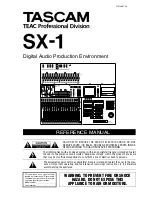
10
TASCAM SX-1
Reference Manual
Part I–Manuals & Conventions
Chapter 1 – The Manuals
Manual Descriptions
There are two different manuals shipped with the
SX-1: a
Quick Start Guide
and an
Owner's Manual
(this manual). If you are missing either of these man-
uals, you should contact the authorized TASCAM
dealer where you purchased your SX-1. The contents
and purpose of each manual are described below.
Owner's Manual
The
Owner's Manual
covers all of the SX-1's many
features, controls, and parameters in detail. Its expla-
nations assume that you have a certain knowledge-
base about recording and MIDI. If you find yourself
confused by the subjects and terms presented in this
manual, you should refer to an introductory hand-
book on engineering. This manual does not explain
how to set up and begin using the SX-1; for that you
should refer to the
Quick Start Guide
.
Quick Start Guide
This guide covers all the basics on setting up your
SX-1: unpacking, connecting speakers, listening to
the demo, setting recording levels, and connecting
MIDI. If you are not familiar with setting up record-
ing equipment (and even if you are) beginning with
the
Quick Start Guide
is a good idea. For more
detailed explanations on individual features and
functions, refer to the
Owner's Manual
.
Manual Organization
The
Owner's Manual
is divided into sections called
Parts, and each Part is divided into chapters. The
Parts are designated by Roman numerals (I, II, III,
IV, etc.) while the chapters are designated by Arabic
numerals (1, 2, 3, 4, etc.). Each chapter contains rele-
vant figures of the SX-1’s front panel, and screen
shots of the LCD and VGA displays.
Each Part covers a specific portion of the SX-1 (for
example, the Mixer or the MIDI Sequencer). The
chapters address individual features (such as mixer
automation or editing MIDI data). As such, learning
about a specific section of the SX-1’s functionality is
as simple as reading the appropriate Part.
There are ten Parts.. The following is a brief descrip-
tion of what you can expect to find in each Part.
I, “Manuals & Conventions” (page 10)
This introductory Part explains the organization and
documentation conventions of the
Owner's Manual
.
It also covers the SX-1's general operating conven-
tions for all three control interfaces: the front panel,
onboard LCD screen, and a connected VGA display.
II, “Monitoring Signals and Selecting
Screens” (page 21)
There are lots of ways to
monitor signals on the SX-1. The front panel meters
and LED indicators are one way, and many of the
display screens also provide comprehensive meter-
ing. This Part covers the SX-1’s many meters and
indicators and explains how to recall the different
display screens.
III, “Locate, Transport, & Surround” (page
31)
Understanding how to navigate through your
project quickly and efficiently is key to getting the
most out of your SX-1. This Part explains the SX-1’s
transport and locate controls as well as its recording
conventions.
IV, “Mixer Controls” (page 45)
The SX-1 has
a full-featured mixer with a host of powerful fea-
tures. Routing for the mixer is available pre- and
post- the mixer channels, the channels themselves
have built-in EQ and dynamics, the buss and return
architecture is extremely flexible, and practically
every parameter can be automated and archived. This
section explains the mixer’s structure and operations.
V, “Effects” (page 106)
Each onboard effect has
is own unique set of parameters. This Part explains
these parameters for all the currently available effect
algorithms.
VI, “Audio tracks” (page 122)
Everything
you need to know about working with and editing
audio regions can be found in this Part. This includes










































